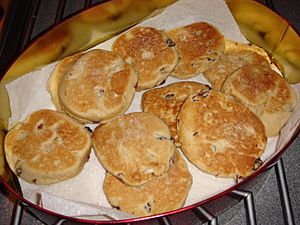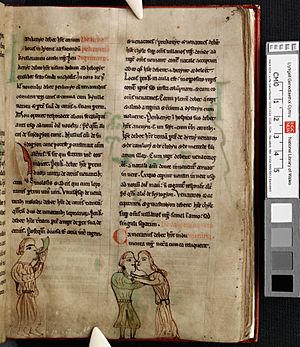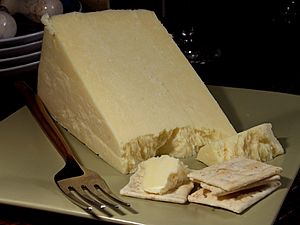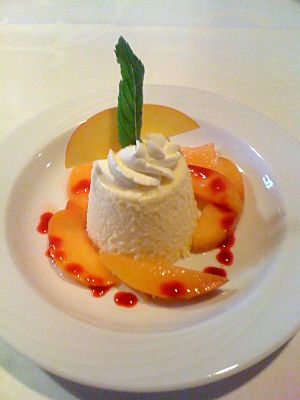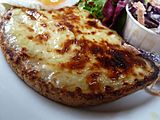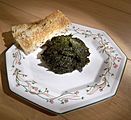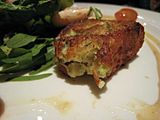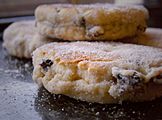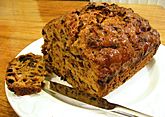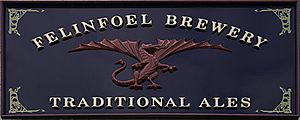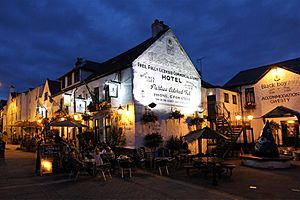Welsh cuisine facts for kids
Welsh cuisine is all about the yummy cooking styles, traditions, and recipes from Wales. Many dishes are considered Welsh because of their ingredients or history. Some famous ones include cawl, Welsh rarebit, laverbread, Welsh cakes, bara brith, and Glamorgan sausage. These foods are like symbols of Wales! You might find some small differences in dishes across the country, especially in the Gower Peninsula. This area was once quite isolated, so people there learned to make their own food.
Even though some cooking ideas came from nearby British countries, unique Welsh food mostly grew from the lives of working people. They were often isolated, so they had to make food with the ingredients they could grow or afford. Long ago, Welsh Celts and their descendants moved their cattle to higher places in summer and brought them back home in winter. Later, when they settled down, families usually ate pork, and kept cows for milk and cheese.
Sheep farming is very common in Wales. So, lamb and mutton are the meats most connected with the country. People also raise beef and dairy cows. Fishing is also a big part of Welsh culture, and seafood is often found in Welsh meals.
In the past, vegetables were rare, except for cabbages and leeks. The leek became super important and is now a national symbol of Wales. It has been for at least 400 years! Even William Shakespeare wrote about Welsh people wearing leeks in his play Henry V.
Since the 1970s, Wales has seen many more restaurants and gastropubs (pubs that serve great food). Today, there are even five restaurants in Wales that have earned special Michelin stars!
Contents
History of Welsh Food
There aren't many old written recipes for traditional Welsh foods. Instead, families kept recipes secret and passed them down by talking, usually from mothers to daughters. Richer families who could write often cooked in English styles, not traditional Welsh ones. This means that Welsh cooking mostly came from the everyday meals of ordinary people, not from fancy kitchens.
Long ago, the Welsh King and his court would travel around, asking for food from the towns they visited. This was written down in the Laws of Hywel Dda. These laws show that people ate beer, bread, meat, and dairy products. They had very few vegetables besides cabbages and leeks. The laws also show that wealth was measured in cattle, and that hunters in the court only hunted during certain seasons.
Around the 11th century, Welsh people started building permanent homes. Food was cooked in a single cauldron over an open fire. Meals might be reheated and new ingredients added over several days. Some dishes were cooked on a bakestone, which is a flat stone heated over a fire.
Gerald of Wales, who visited Wales in 1188, wrote that people mostly ate oats, milk, cheese, and butter. He said not to expect many different dishes or fancy flavors from a Welsh kitchen. Medieval Welsh cooks used herbs like thyme, savory, and mint, but mostly for medicine, not for cooking.

By the late 1700s, landowners in Wales started dividing their land for tenant farmers. Each small farm would grow vegetables and have a cow, pigs, and a few chickens. The 18th and 19th centuries were tough times for Welsh people. There were food shortages, and people sometimes rioted, especially in the 1790s when grain was scarce. Magistrates sometimes sold grain at lower prices to calm things down.
Around the late 1800s, more coal mining and steel works brought Italian workers to Wales. These families shared their culture, bringing Italian ice cream and cafes, which are now a common sight in Wales.
In the 1960s, people in isolated Welsh communities couldn't easily get foods like peppers or aubergines. There weren't many special Welsh products. Farms rarely made their own cheese, and Welsh wine wasn't very good. But by the 1990s, old Welsh foods started to become popular again! Farmers' markets grew, and Welsh organic vegetables and farm-made cheese appeared in supermarkets. Today, Welsh restaurants proudly use local ingredients to create new dishes. This means Welsh products can even be found in fancy food shops in big cities!
Different Foods in Different Areas
The foods eaten in different parts of Wales can vary. This goes back to how people cooked in medieval times. What people ate depended on what could be grown. In wet, hilly areas, only oats grew well. In more fertile lowlands, barley or wheat could be grown. People near the coast ate more seafood or seaweed, while those inland added seeds from wild plants to their meals if they didn't have enough grain.
When the Romans and Normans invaded, they influenced the fertile areas they conquered. People there learned more "fancy" ways of eating. But those in wilder areas kept their traditional cooking methods.
The Gower peninsula is one area that stands out. It was hard to get there by land, so it was quite isolated. Instead, it was influenced by places across the Bristol Channel, like Somerset and Devon. Dishes like whitepot and ingredients like pumpkin, which were rare elsewhere in Wales, became common in Gower.
Welsh Ingredients
We can learn a lot about Welsh food by looking at its ingredients through history.
Meat and Fish
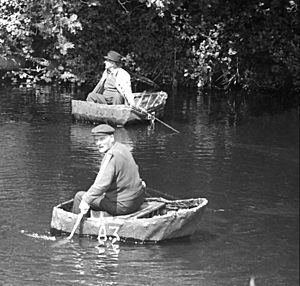
Wales has its own local cow breeds, like the Welsh Black cattle, which has been around since at least 1874. Raising cattle is a big part of farming in Wales. Welsh beef even has a special European Union label, meaning it must be raised and killed entirely in Wales.
Pigs were the main meat for early Welsh people because their meat could be easily preserved with salt. Today, Welsh pigs are either raised in large farms (like the white Welsh pig) or smaller, outdoor farms (like the British Saddleback or Welsh pig).
The Welsh hills are perfect for grazing animals like sheep and goats, so these animals became linked with Wales. Large-scale sheep farming was started by monks, mostly for wool, but also for meat. By the 1500s, Welsh mutton was popular across the UK. Now, Welsh sheep are mostly raised for meat. The most popular breed is the Welsh Mountain sheep. They are smaller but fit well in the Welsh landscape and are known for their tasty meat.
Coastal areas and rivers in Wales provide many kinds of fish and shellfish. Old fishing methods, like using nets for salmon, were used for 2,000 years! Welsh coracles, which are simple boats made of willow and animal hides, were used even in the 20th century. Once caught, fish were often dried by the wind, smoked, or cured with salt.
Herring, a fish that salts well, was a popular catch. Many villages fished for herring, usually from late August to December. Herring, along with mackerel, trout, salmon, and sea trout, were the main fish in Welsh cooking. Salmon was so common that it was a basic food for poor people. Trout was often wrapped in leek leaves or covered in bacon to keep it from drying out when cooked. Many fish were served with fennel, which grew wild in Wales.
Lobster fishing was small-scale and mostly for selling to other countries. Welsh fishermen were more likely to eat the less expensive crabs. Cockles have been gathered since Roman times and are still collected by hand today in the Gower peninsula.
Dairy Products
Since cattle were a sign of wealth for the Celts, butter and cheese were usually made from cow's milk. The Celts were among the first in Britain to make butter, and for hundreds of years, butter was the main way to cook and make sauces. Salt was important in Welsh butter and early Welsh cheeses, which were soaked in salty water.
The Welsh also loved roasted cheese. An early version of Welsh rarebit was made in medieval times, and by the mid-1400s, it was seen as a national dish. The soil in Wales meant that their cows' milk made a soft cheese, which wasn't great for roasting. So, Welsh people would trade for harder cheeses like Cheddar.
The most famous Welsh cheese is Caerphilly, named in 1831 but made much earlier. It was originally a way to store extra milk. After World War II, making Caerphilly stopped for a while in Wales, but it was still made in England. There, it was made quickly, resulting in a drier cheese. In the 1970s, Caerphilly production returned to Wales, and many new Welsh cheeses have been made since then.
Grains
Even in the Iron Age, Welsh people used wild grains to make a rough bread. By the time the Romans arrived, Celts were skilled enough to make white or brown breads. When the Romans invaded, many Welsh people moved to the less fertile uplands. There, the only grains they could grow were oats, barley, and rye. Oat and barley breads were the main breads eaten in Wales until the 1800s. Oats were also used to thicken meat and vegetable stews, called pottage.
The Welsh also made a dish called llymru. This was finely ground oatmeal soaked in water for a long time, then boiled until it became solid. This dish became so popular outside Wales that it got a new name, flummery, because English people couldn't say the original name. A similar dish, sucan, was made with coarser oatmeal.
Vegetables
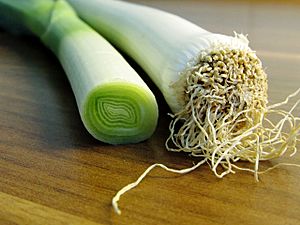
Old Celtic laws specifically mentioned cabbages and leeks, saying they should be protected by fences from wandering cattle. These two green vegetables were the only ones mentioned, though wild plants were probably used too. The leek became so important in Welsh cooking—found in many famous dishes like cawl and Glamorgan sausage—that it became the country's national vegetable.
Potatoes were slow to become popular in Wales, even though they came to the UK in the 1500s. It wasn't until the early 1700s that they became a main food in Wales, especially when grain crops failed. Once potatoes became common, they quickly appeared in Welsh dishes like cawl.
Famous Welsh Dishes
While many dishes can be called Welsh because of their ingredients, some are truly special to Wales. Dishes like cawl, Welsh rarebit, laverbread, Welsh cakes, bara brith (which means "speckled bread"), and Glamorgan sausage are all symbols of Welsh food.
Cawl, pronounced like "cowl," is often called Wales' national dish. It dates back to the 11th century. Originally, it was a simple soup of meat (likely bacon) and vegetables. It could cook slowly all day while the family worked. It could even be made in stages over several days: first a meat broth, then vegetables added the next day. Once cooked, the fat could be skimmed off. It was often served as two separate parts: first the soup, then the stew. Leftovers could be topped up with fresh vegetables, sometimes for weeks!
In the 1700s and 1800s, very little meat was used in cawl; instead, it was filled out with potatoes. Today, cawl is more likely to have beef or lamb. It might be served with plain oatmeal dumplings or currant dumplings called trollies. Traditionally, cawl was eaten with a special wooden spoon from a wooden bowl.
Welsh people loved roasted cheese, which led to the dish Welsh rarebit, or Welsh rabbit. This is seasoned melted cheese poured over toasted bread. The cheese needs to be a harder type, like cheddar. It was called Welsh rabbit as early as 1725. The name probably came from a joke about the Welsh, as they rarely ate rabbit. The name later changed from "rabbit" to "rarebit," perhaps to make it sound nicer.
Laverbread, or Bara Lawr, is a Welsh specialty. It's made by cooking porphyra seaweed slowly for up to ten hours until it becomes a smooth paste called laver. The seaweed can also be cooked with oatmeal to make laverbread. It's often served with bacon and cockles for breakfast, or fried into small patties. Today, laverbread is made in factories by washing, cooking, chopping, salting, and packaging the seaweed.
The Glamorgan sausage is a Welsh vegetarian sausage. It has no meat! Instead, it's made with cheese (usually Caerphilly, sometimes cheddar) and leek or spring onion. This mix is then covered in breadcrumbs, shaped like a sausage, and cooked. Glamorgan sausages have been around since at least the early 1800s.
Welsh cakes, or pice ar y maen (meaning "cakes on the stone"), are small, round, spiced cakes. They were traditionally cooked on a bakestone, but now often on a griddle. Once cooked, you can eat them hot or cold, plain, or with sugar or butter. The dough, mixed with raisins, sultanas, and sometimes currants, is like shortbread. So, they can feel like biscuits when cooked on a griddle, or a bit more like a cake when baked in an oven.
Bara brith is a fruit loaf from rural Wales. People used to grind fresh sweet spices with a mortar and pestle. In the past, it was made with yeast and butter, but now it's often made with baking soda and margarine. The dried fruits (raisins, currants, candied peel) are soaked in cold tea before baking. It's usually served sliced with butter during afternoon tea. Bara Brith means "speckled bread." It's also known as teisen dorth in South Wales, or torta negra when Welsh settlers took it to Argentina.
-
Tatws Pum Munud, Welsh stew, with smoked bacon, stock, potatoes
Drinks
Wine and beer, especially homemade kinds, were very important for social gatherings in Wales, just like in England. Beer is now the national drink of Wales. The Felinfoel Brewery even became the first brewery in Europe to sell beer in cans!
The Welsh also have a history of making whisky, similar to Irish or Scottish whisky, but on a smaller scale. Commercial whisky making started before 1750. The main whisky production in Wales was at Frongoch near Bala, Gwynedd, but it closed in 1910. In 1998, the Welsh Whisky Company, now called Penderyn, was formed. They started making whisky in 2000, and Penderyn single malt whisky went on sale in 2004. It was the first commercially made Welsh whisky in a century! The company also makes other drinks like Merlyn Cream Liqueur, Five Vodka, and Brecon Gin.
It's not certain if Romans planted vineyards in Wales, but in the 1970s, new vineyards were planted in South Wales to make Welsh wine. By 2005, Wales had 20 vineyards, making 100,000 bottles a year, mostly white wines. By 2015, there were 22 vineyards and almost 40 hectares (about 100 acres) of grapevines in Wales.
By 2005, the Welsh bottled water industry was worth a lot of money! Popular brands include Brecon Carreg, Tŷ Nant, Princes Gate, and Pant Du.
Eating Out
The number of restaurants in Wales has grown a lot since the 1960s. Back then, there weren't many famous places to eat out. Today, Wales is known for its great food! As of 2016, it has five Michelin star restaurants, and many Welsh restaurants are listed in other award systems like TripAdvisor. The biggest growth has been in fancy restaurants, but the quality of all kinds of Welsh eateries has improved.
Many Welsh restaurants proudly show off their local ingredients and create new dishes with them. There has also been a rise in Asian cuisine in Wales, especially Indian, Chinese, Thai, Indonesian, and Japanese food. People in Wales also love "gastropubs," which are pubs that serve really good food.
See also
 In Spanish: Gastronomía de Gales para niños
In Spanish: Gastronomía de Gales para niños


